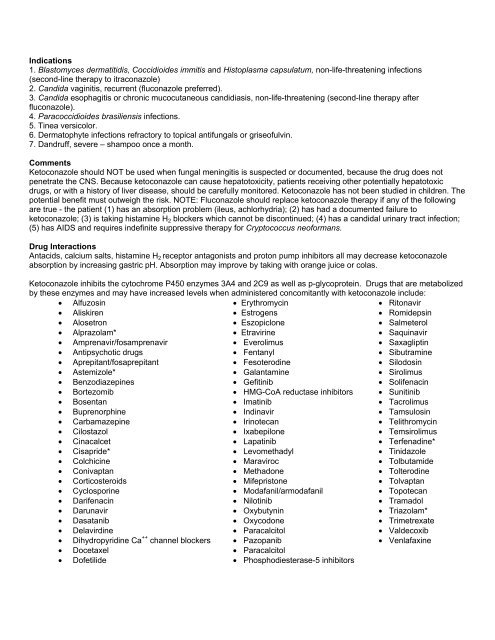Antimicrobial Use Guidelines (AMUG) version 21 - UW Health
Antimicrobial Use Guidelines (AMUG) version 21 - UW Health
Antimicrobial Use Guidelines (AMUG) version 21 - UW Health
You also want an ePaper? Increase the reach of your titles
YUMPU automatically turns print PDFs into web optimized ePapers that Google loves.
Indications1. Blastomyces dermatitidis, Coccidioides immitis and Histoplasma capsulatum, non-life-threatening infections(second-line therapy to itraconazole)2. Candida vaginitis, recurrent (fluconazole preferred).3. Candida esophagitis or chronic mucocutaneous candidiasis, non-life-threatening (second-line therapy afterfluconazole).4. Paracoccidioides brasiliensis infections.5. Tinea versicolor.6. Dermatophyte infections refractory to topical antifungals or griseofulvin.7. Dandruff, severe – shampoo once a month.CommentsKetoconazole should NOT be used when fungal meningitis is suspected or documented, because the drug does notpenetrate the CNS. Because ketoconazole can cause hepatotoxicity, patients receiving other potentially hepatotoxicdrugs, or with a history of liver disease, should be carefully monitored. Ketoconazole has not been studied in children. Thepotential benefit must outweigh the risk. NOTE: Fluconazole should replace ketoconazole therapy if any of the followingare true - the patient (1) has an absorption problem (ileus, achlorhydria); (2) has had a documented failure toketoconazole; (3) is taking histamine H 2 blockers which cannot be discontinued; (4) has a candidal urinary tract infection;(5) has AIDS and requires indefinite suppressive therapy for Cryptococcus neoformans.Drug InteractionsAntacids, calcium salts, histamine H 2 receptor antagonists and proton pump inhibitors all may decrease ketoconazoleabsorption by increasing gastric pH. Absorption may improve by taking with orange juice or colas.Ketoconazole inhibits the cytochrome P450 enzymes 3A4 and 2C9 as well as p-glycoprotein. Drugs that are metabolizedby these enzymes and may have increased levels when administered concomitantly with ketoconazole include:• Alfuzosin • Erythromycin • Ritonavir• Aliskiren • Estrogens • Romidepsin• Alosetron • Eszopiclone • Salmeterol• Alprazolam* • Etravirine • Saquinavir• Amprenavir/fosamprenavir • Everolimus • Saxagliptin• Antipsychotic drugs • Fentanyl • Sibutramine• Aprepitant/fosaprepitant • Fesoterodine • Silodosin• Astemizole* • Galantamine • Sirolimus• Benzodiazepines • Gefitinib • Solifenacin• Bortezomib • HMG-CoA reductase inhibitors • Sunitinib• Bosentan • Imatinib • Tacrolimus• Buprenorphine • Indinavir • Tamsulosin• Carbamazepine • Irinotecan • Telithromycin• Cilostazol • Ixabepilone • Temsirolimus• Cinacalcet • Lapatinib • Terfenadine*• Cisapride* • Levomethadyl • Tinidazole• Colchicine • Maraviroc • Tolbutamide• Conivaptan • Methadone • Tolterodine• Corticosteroids • Mifepristone • Tolvaptan• Cyclosporine • Modafanil/armodafanil • Topotecan• Darifenacin • Nilotinib • Tramadol• Darunavir • Oxybutynin • Triazolam*• Dasatanib • Oxycodone • Trimetrexate• Delavirdine • Paracalcitol • Valdecoxib• Dihydropyridine Ca ++ channel blockers • Pazopanib • Venlafaxine• Docetaxel • Paracalcitol• Dofetilide • Phosphodiesterase-5 inhibitors
















